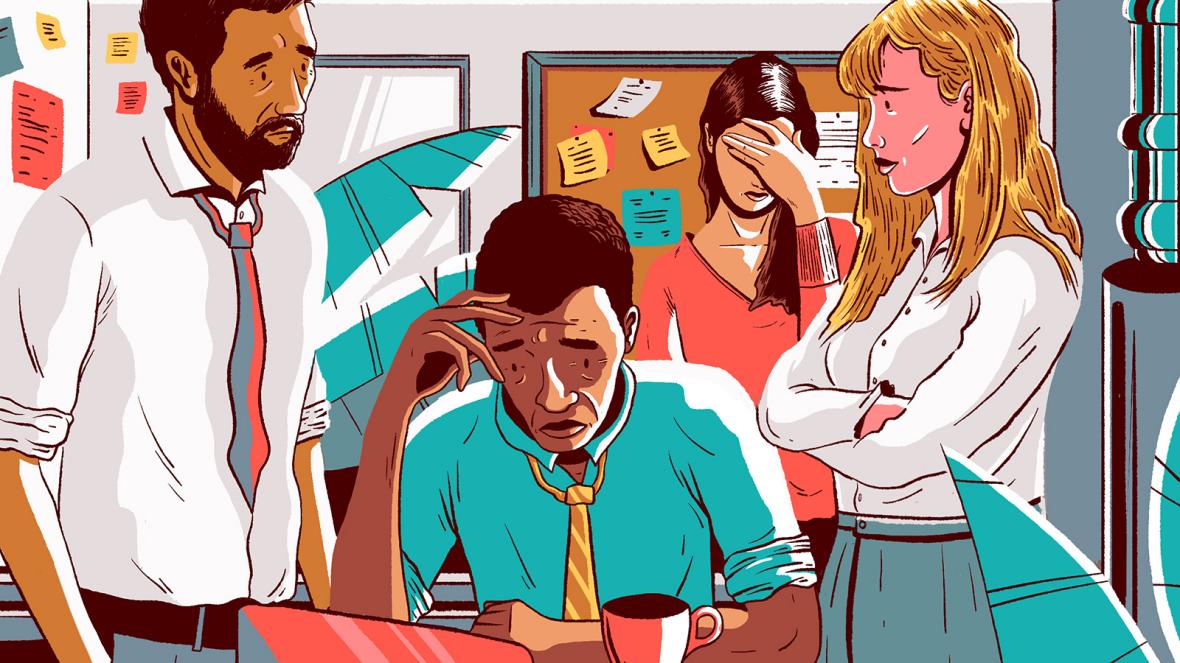WORKPLACE Harassment : #MenToo Suffer

WORKLACE, a location where someone works for their employer, a place of employment. Such a place can range from a home office to a large office building, factory or university. Workplace harassment is a form of discrimination that violates Title VII of the Civil Rights Act of 1964 and other federal regulations, including the Age Discrimination in Employment Act of 1967, and the Americans with Disabilities Act of 1990.
The Equal Employment Opportunity Commission (EEOC) defines harassment as unwelcome verbal or physical behavior that is based on race, colour, religion, sex, gender/gender identity, nationality, age (40 or older), physical or mental disability or genetic information. Harassment prohibits speech or action which is severe or pervasive enough to create a “hostile or abusive work environment.”
We usually came across the harassment faced by women at their workplaces, but what if a man is also facing the same, what if she is taking the advantage of her being a boss, what if she is taking advantage of her coming from a family with a strong political background, what if she is threatening them with the laws made for her protection and what if she is taking the advantage of her being a woman.
Various types of Harassments faced by a Male at Their workplace:
1. Discrimination Harassment: It includes;
a. Racial Harassment: A victim may experience racial harassment because of their race, skin colour, ancestry, origin country or citizenship. Even perceived attributes of a certain ethnicity (curly hair, accents, customs, beliefs or clothing) may be the cause. Racial harassment often looks like:
● Racial slurs ● Racial insults ● Racial jokes ● Degrading comments ● Disgust ● Intolerance of differences.
b. Gender Harassment
Gender-based harassment is discriminatory behaviour towards a person based on their gender. Negative gender stereotypes about how should or do act, are often the centre of the harassment. Some examples are:
● A male nurse faces harassment for having what is perceived as a woman’s job.
● A male colleague displays material (comics, posters) that’s degrading to women.
c. Religious Harassment
Religious harassment is often interconnected with racial harassment but narrows in specifically on the victim’s religious beliefs. An individual with a religion that differs from the “norm” of the company may face workplace harassment or intolerance in a variety of ways:
● Intolerance toward religious holidays ● Intolerance toward religious traditions● Intolerance toward religious customs
● Degrading stereotypical comments ● Pressures to convert religions ● Cruel religious jokes
d. Disability-Based Harassment
Disability-based harassment is a type of workplace harassment directed towards individuals who either:
● Suffer from a disability ● Are acquainted with a disabled person or people
● Use disability services (sick leave or workers’ comp)
A person with a disability may experience harassment in the form of harmful teasing, patronizing comments, refusals to reasonably accommodate or isolation.
e. Sexual Orientation-Based Harassment
Sexual orientation-based harassment is starting to gain traction and recognition as a legitimate type of workplace harassment. Victims face harassment because their sexual orientation is different from those around them. People of any sexual orientation (heterosexual, homosexual, bisexual, asexual, etc.) may experience this form of harassment depending on their line of work.
f. Age-Based Harassment
Workers 40 years and older are specifically protected by the Civil Rights Act of 1964 in an attempt to promote the employment of older people and reduce age-based harassment.
A person facing age-based harassment might be:
● Teased and insulted ● Left out of activities or meetings, or ● Unfairly criticize
Simply because of their age and the stereotypes that come with it. Unfortunately, this harassment is sometimes an attempt to wrongfully push the individual into early retirement.
2. Personal Harassment
Personal harassment is a form of workplace harassment that’s not based on one of the protected classes (such as race, gender or religion). Simply, it is bullying in its most basic form and it’s not illegal but can be damaging, nevertheless. This is the most common type of harassment faced by men at their workplaces.
Examples of Personal Harassment:
● Inappropriate comments ● Offensive jokes ● Personal humiliation ● Critical remarks
● Ostracizing behaviours or any other behaviour that creates an intimidating and offensive work environment for the victim ● Intimidation tactics.
3. Physical Harassment
Physical harassment, also often called workplace violence, refers to a type of workplace harassment that involves physical attacks or threats. In extreme cases, physical harassment may be classified as assault. Physical gestures such as playful shoving can blur the line between appropriate or not since it is the person on the receiving end who decides whether the behaviour makes them uncomfortable. In order to more clearly define that line, physical harassment should be taken very seriously in the workplace and explained thoroughly in codes of conduct and policies.
Common behaviours include:
● Direct threats of intent to inflict harm ● Physical attacks (hitting, shoving, kicking)
● Threatening behaviour (shaking fists angrily) ● Destroying property to intimidate.
4. Power Harassment
Power harassment is a common form of workplace harassment that is characterized by a power disparity between the harasser and the harassed. The harasser exercises their power by bullying a victim who is lower on the office hierarchy. In many cases, the harasser is a supervisor or manager who victimizes their subordinates.
Power harassment is not limited to a certain type of behaviour. It can be verbal in the form of intimidation or it can be physical in the form of acts of violence. More often it is psychological. The harasser subjects the victim to:
● Excessive demands that are impossible to meet ● Demeaning demands far below the employee’s capability ● Intrusion into the employee’s personal life
5. Psychological Harassment
Psychological harassment has a negative impact on a person’s psychological well-being. Victims of psychological harassment often feel put down and belittled on a personal level, a professional level or both. The damage to a victim’s psychological well-being often creates a domino effect, impacting their physical health, social and work life.
Psychological harassment in the workplace might look like:
● Isolating or denying the victim’s presence ● Belittling or trivializing the victim’s thoughts
● Discrediting or spreading rumours about the victim ● Opposing or challenging everything the victim says.
6. Cyber Bullying
Employers are embracing new technology in order to appeal to younger employees and reap the benefits of a digitally connected world. For example, instant messaging applications such as WhatsApp and Facebook offer convenience, speed and user-friendly interface. However, there can be a downside to this digital world.
Cyberbullying and online harassment are a serious concern for employers. Among many, many other things, online bullies may:
● Share humiliating things about the victim by mass email or mass chat
● Spread lies or gossip about the victim on social media
● Send harassing instant messages or text messages directly to the victim.
7. Retaliation
Retaliation harassment is a subtle form of retaliation and an often-overlooked type of workplace harassment. Retaliation harassment occurs when a person harasses someone else to get revenge and to prevent the victim from behaving in such a way again.
This type of harassment typically has three parts:
● Employee A files a complaint about Employee B.
● Employee B finds out about the complaint and who made it.
● Employee B harasses Employee A to get revenge and deter them from filing further complaints.
● Employee B, in this case, would be harassing Employee A as retaliation.
8. Third Party Harassment
Third-party harassment is a type of workplace harassment that’s perpetrated by a “third party” – someone from outside of the organization (Her relative with a high-ranking post). Victims are often young adults in “low-status” or “low-power” jobs (think: cashier or sales associate). Their position in the company, their lack of experience and their reluctance to cause a scene makes them ideal victims.
9. Verbal Harassment
Verbal harassment can be the result of personality conflicts in the workplace that have escalated beyond the casual eye roll or something more serious. Unlike discriminatory types of harassment (such as sexual), verbal abuse is often not illegal. Instead, verbal harassment can be someone who’s consistently mean or unpleasant. For this reason, a lot of verbal harassment can be particularly damaging since it goes unnoticed and unresolved.
10. Smokers and Non-smokers
A number of states have statutes that prohibit discrimination and/or harassment on the basis of a person’s status as a smoker, or as a non-smoker in some states.
WHAT TO DO?
1) Keep a record of all harassment incidents.
2) Get witnesses
3) Stay calm and professional
4) Arrange a meeting with the head of the organization
5) Be sure to follow up your complaint
6) Seek legal help
7) Take help from NGOs
Sameena Lone
The Writer Is the member Of Kashmir Youth Web & Youth For Drug Free Kashmir


